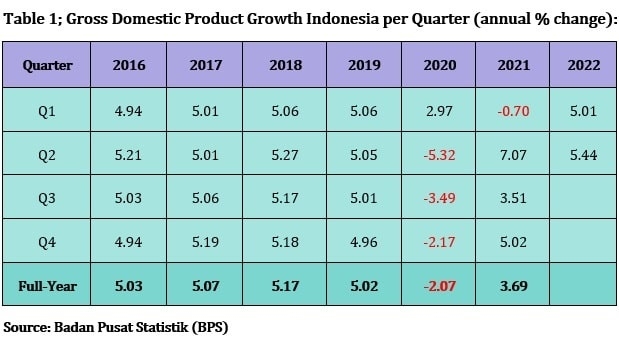Economic Growth of Indonesia Better-Than-Expected in Q2-2022
In our July 2022 report we asked ourselves the question: ‘should we become more optimistic about Indonesia’s economic growth?’ since our outlook for the Indonesian economy in Q2-2022 fell out of tune with the general consensus held by a selection of international and domestic institutions. While our pessimistic stance served us well in 2020 and 2021 (when our projections also fell out of tune with the general consensus), this time it is our side that needs to revise its stance
The above-mentioned question was answered by Indonesia’s Statistical Agency (in Indonesian: Badan Pusat Statistik, or BPS) when it released the latest Q2-2022 gross domestic product (GDP) of Indonesia on 5 August 2022. The Indonesian economy expanded by 5.44 percent year-on-year (y/y) in the second quarter of the year, well above our forecast of 4.5 percent (y/y) and even above the general consensus (that we estimate averaged around 5.3 percent y/y). This makes it all the more interesting to take a look at where exactly the better-than-expected growth originates from.
With economic activity coming in better-than-expected in Q2-2022 it also allows for a more optimistic attitude toward economic expansion in the remainder of the year, although a number of significant challenges persist that could undermine growth.
Table 1 (above) shows the annual GDP growth rates of Indonesia, per quarter. The 5.44 percent (y/y) growth rate in Q2-2022 is an improvement from the 5.01 percent (y/y) growth rate set in the preceding quarter – despite the higher base as growth had rebounded 7.07 percent (y/y) in Q2-2021. A key advantage of Q2 in both 2021 and 2022 (compared to Q1) was that the Ramadan and Idul Fitri celebrations took place in April/May, and so consumption peaked (implying more goods and services needed to be produced or provided, and transported, or – in other words – a boost in economic activity).

Before we delve into the data, we can reveal that there are two factors that especially supported Indonesia’s economic growth in Q2-2022:
(1) Solid growth of household consumption on the back of easing concerns over the COVID-19 virus as well as loser social and corporate restrictions; and
(2) Very impressive export growth thanks to high commodity prices (although palm oil exports experienced a hiccup amid a temporary government palm oil export ban, while imports rose at a much slower pace (allowing a comfortable trade surplus).
What is also interesting to mention here is that government spending continued to contract – quite understandably as the government needs to cut spending in order to safeguard a healthy government budget balance. Moreover, the need for social and corporate assistance spending is waning as restrictions are eased. Interestingly enough though, the government’s budget balance showed a rare surplus of IDR 73.6 trillion (approx. USD $5 billion, or 0.39 percent of GDP) in the first half of 2022. This implies that there certainly is room for more government spending. However, a drop in global commodity prices can rapidly turn the tables (making the energy subsidies – funded through windfall revenue from coal and palm oil exports – a major financial burden), and so we can understand it if policymakers are hesitant to engage in new long-term, capital-intensive public assistance spending programs at this point.
[...]
This is the introduction of the article. If you want to buy the full article you can contact us by sending an email to [email protected] or a message to +62.882.9875.1125 (including WhatsApp).
Take a glance inside the report here!
Price of this report:
Rp 50,000 (43 pages, in PDF)
